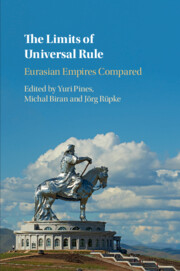Book contents
- The Limits of Universal Rule
- The Limits of Universal Rule
- Copyright page
- Contents
- Maps
- Figures
- Contributors
- Abbreviations
- Preface
- Introduction
- 1 From the Mediterranean to the Indus Valley: Modalities and Limitations of the Achaemenid Imperial Space
- 2 Limits of All-Under-Heaven: Ideology and Praxis of “Great Unity” in Early Chinese Empire
- 3 The Roman Empire
- 4 The Medieval Roman Empire of the East as a Spatial Phenomenon (300–1204 CE)
- 5 Early Islamic Imperial Space
- 6 The Mongol Imperial Space
- 7 The Territories and Boundaries of Empires
- 8 Delimiting the Realm Under the Ming Dynasty
- 9 The Expansion of the Qing Empire Before 1800
- 10 All Under the Tsar
- Index
- References
1 - From the Mediterranean to the Indus Valley: Modalities and Limitations of the Achaemenid Imperial Space
Published online by Cambridge University Press: 07 January 2021
- The Limits of Universal Rule
- The Limits of Universal Rule
- Copyright page
- Contents
- Maps
- Figures
- Contributors
- Abbreviations
- Preface
- Introduction
- 1 From the Mediterranean to the Indus Valley: Modalities and Limitations of the Achaemenid Imperial Space
- 2 Limits of All-Under-Heaven: Ideology and Praxis of “Great Unity” in Early Chinese Empire
- 3 The Roman Empire
- 4 The Medieval Roman Empire of the East as a Spatial Phenomenon (300–1204 CE)
- 5 Early Islamic Imperial Space
- 6 The Mongol Imperial Space
- 7 The Territories and Boundaries of Empires
- 8 Delimiting the Realm Under the Ming Dynasty
- 9 The Expansion of the Qing Empire Before 1800
- 10 All Under the Tsar
- Index
- References
Summary
Alexander the Great's victories over Darius III and his satraps between 334 and 323 BCE have been for very long interpreted as the reliable testimony of the intrinsic feebleness and internal fragility of the Achaemenid empire, which expanded from Central Asia to Aswan and from the Indus to the Mediterranean Sea, and lasted for more than two centuries (c.550–330). And yet, notwithstanding the exceptional cultural and political diversity of the countries and peoples under the empire’s rule, the central authorities exercised a permanent control upon lands and seas. The best way for understanding the originality of such an ancient empire is to rule out the usual tricky alternative centralization versus independence/autonomy. Cultural diversity and imperial power are not mutually exclusive. The main feebleness of such a political construction was that, in front of a powerful (Macedonian) invasion, the central power could not count on any imperial ideology which would be shared by all the cultural components of the empire.
- Type
- Chapter
- Information
- The Limits of Universal RuleEurasian Empires Compared, pp. 49 - 78Publisher: Cambridge University PressPrint publication year: 2021
References
- 5
- Cited by

